Baked Potatoes
- By Jennifer Segal
- Updated August 8, 2025
- 32 Comments
- Leave a Review

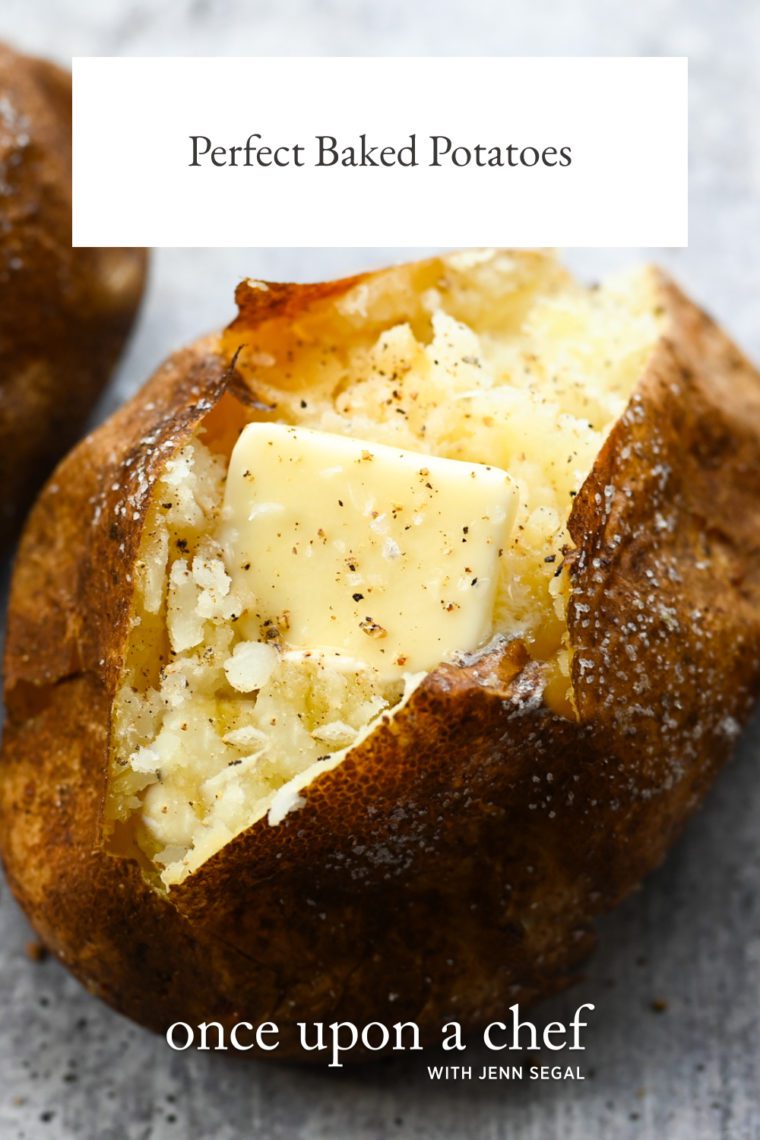
This post may contain affiliate links. Read my full disclosure policy.
Learn how to make the ultimate baked potato—crisp skin, fluffy center, and just the right amount of salt. All it takes is a hot oven and a few basic ingredients.
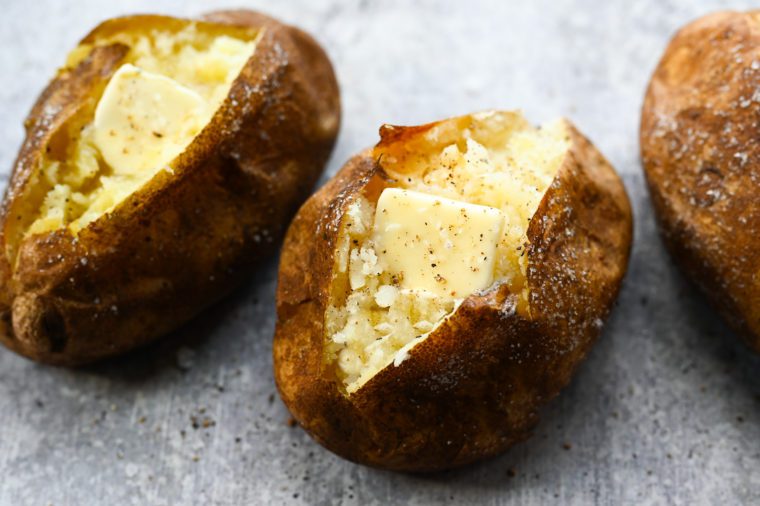
Crispy on the outside, soft and fluffy on the inside—that’s the hallmark of the perfect baked potato. Once split open, the steaming interior becomes the ultimate base for toppings, from butter and sour cream to ranch dressing or crumbled bacon.
While there are countless opinions on how to achieve potato perfection, my baked potato recipe is simple. No foil, no microwaving, no bed of salt—just a generous rub of oil, a sprinkle of salt, and an hour in a 400°F oven. The result: potatoes that are tender inside with a beautifully crispy, seasoned skin.
Craving baked sweet potatoes instead? I follow the same method but bump up the oven temp to draw out their rich, natural sweetness. Or, turn your potatoes into the ultimate comfort food with easy potato soup recipe—basically a loaded baked potato in soup form!
“Who knew baked potatoes could have so much kid-appeal? They went crazy over the fluffy insides! This is my baked potato recipe going forward.”
What You’ll Need To Make Baked Potatoes
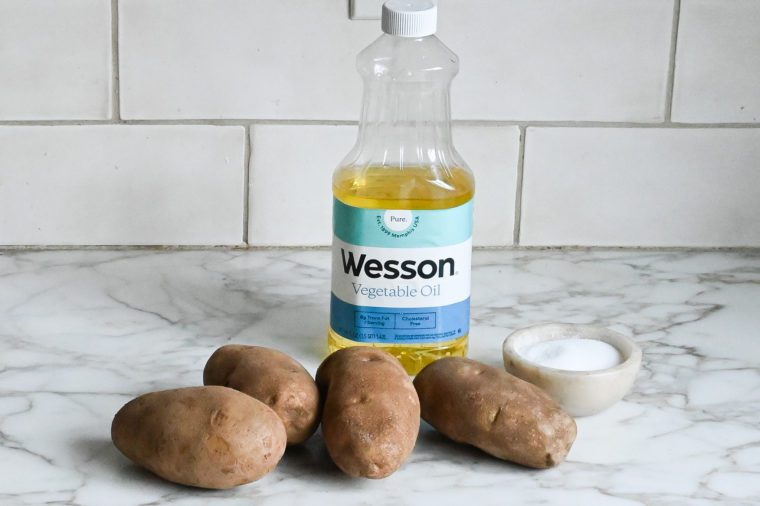
- Russet potatoes – Also known as Idaho potatoes, russet are ideal for making baked potatoes. They are large with a long oval shape and brown skin. Their flesh is starchy, so they become fluffy when cooked. They’re also for making mashed potatoes, french fries, and potato latkes. Prior to cooking, the potatoes should be scrubbed clean of any dirt, rinsed, and dried.
- Salt – Enhances the natural flavor of the potatoes and adds a deliciously seasoned, crispy skin.
- Oil – Coats the potatoes to create that perfect golden, crispy exterior. I use vegetable oil but you can use olive oil if you prefer.
- Jump to the printable recipe for precise measurements
Step-by-Step Instructions
Step 1: Prep the potatoes. Preheat the oven to 400°F and set a rack in the middle position. Line a baking sheet with aluminum foil. Prick the potatoes with a fork (see pro tip), place the potatoes directly on a foil-lined sheet, rub them all over with oil, and sprinkle with salt.
Pro tip: Conventional cooking wisdom says to prick potatoes before baking to let steam escape and prevent them from bursting in the oven. I never bother—and I’ve never had one explode—but it doesn’t hurt, so if it gives you peace of mind, go ahead and do it.
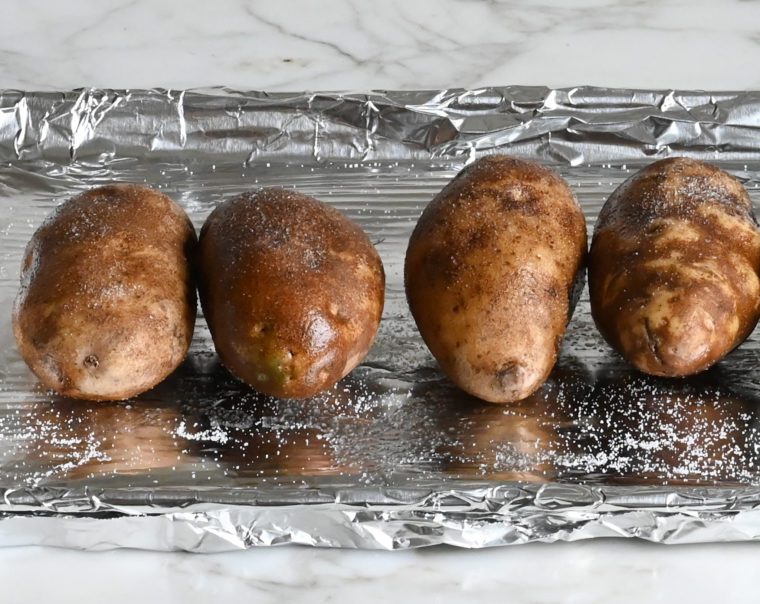
Step 2: Bake the potatoes. Bake for 60 to 70 minutes, until the potatoes are tender when pierced in the center with a sharp knife. Not sure if they’re done? Use a digital thermometer—the center of the largest potato should be between 205°F and 210°F. You can also give them a gentle squeeze to check for softness (just be careful—they’ll be hot!).
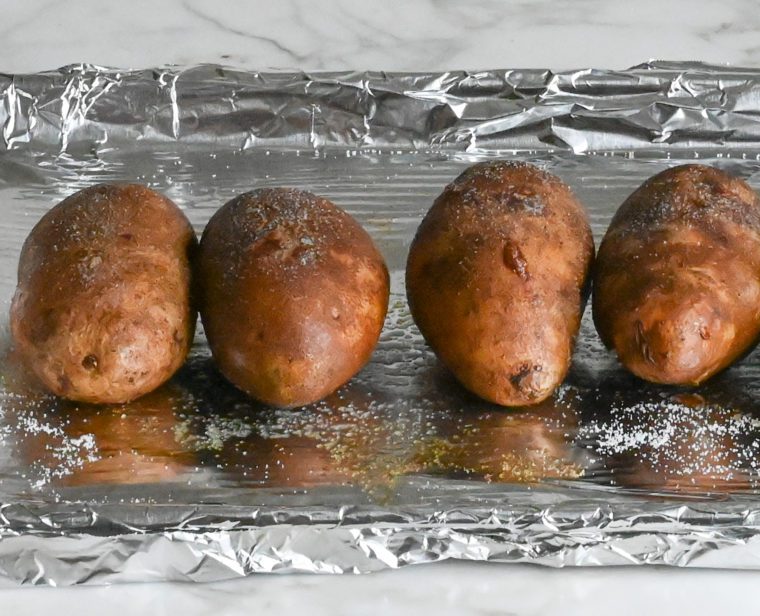
Step 3: Cool slightly and add toppings. Let the potatoes sit for a few minutes until cool enough to handle. Cut a slit down the center of each potato and serve with toppings of choice.

Baked Potato Toppings
Now that you’ve mastered the perfect baked potato, it’s time for the fun part: toppings. Keep it simple or turn it into a full meal. Here are a few favorite combinations:
- Classic: Butter, sour cream, crispy bacon, chives or scallions, shredded cheese (cheddar, Monterey Jack, Gruyère, Parmesan, or blue cheese crumbles)
- Veggie-Loaded: Roasted broccoli, roasted cauliflower, or roasted Brussels sprouts with olive oil and Parmesan
- Chili-Style: Beef chili or turkey chili, shredded cheese, sour cream, scallions
- Taco-Inspired: Spiced ground beef taco (or chicken taco) filling, salsa, shredded cheese, sour cream, maybe a few crushed tortilla chips
You May Also Like
Baked Potatoes
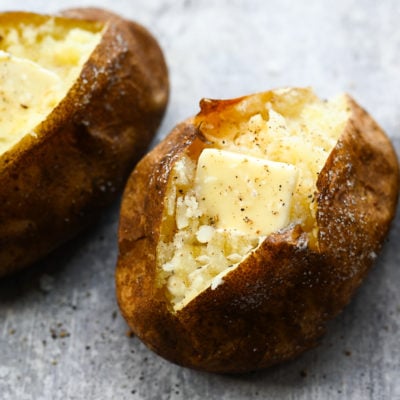
Ingredients
- 4 large russet potatoes, scrubbed clean of dirt, rinsed and dried
- 2 teaspoons vegetable or olive oil
- ½ teaspoon salt
Instructions
- Preheat the oven to 400°F (205°C) and set an oven rack in the middle position. Line a baking sheet with aluminum foil.
- Prick each potato a few times all over with a fork, if you like (see note). Directly on the baking sheet, rub the potatoes with the oil and sprinkle all over with the salt. Bake until tender when pierced in the center with a sharp knife (or until the center of the largest potato registers 205°F/96°C to 210°F/99°C), 60 to 70 minutes. You can also squeeze the potatoes to see if they are soft (be careful; they're hot!). Let sit for a few minutes until cool enough to handle, then cut a slit down the center of each potato and serve with toppings of choice.
Notes
Nutrition Information
This website is written and produced for informational purposes only. I am not a certified nutritionist and the nutritional data on this site has not been evaluated or approved by a nutritionist or the Food and Drug Administration. Nutritional information is offered as a courtesy and should not be construed as a guarantee. The data is calculated through an online nutritional calculator, Edamam.com. Although I do my best to provide accurate nutritional information, these figures should be considered estimates only. Varying factors such as product types or brands purchased, natural fluctuations in fresh produce, and the way ingredients are processed change the effective nutritional information in any given recipe. Furthermore, different online calculators provide different results depending on their own nutrition fact sources and algorithms. To obtain the most accurate nutritional information in a given recipe, you should calculate the nutritional information with the actual ingredients used in your recipe, using your preferred nutrition calculator.
Gluten-Free Adaptable Note
To the best of my knowledge, all of the ingredients used in this recipe are gluten-free or widely available in gluten-free versions. There is hidden gluten in many foods; if you're following a gluten-free diet or cooking for someone with gluten allergies, always read the labels of your ingredients to verify that they are gluten-free.
Comments
Add a Comment Cancel reply
This site uses Akismet to reduce spam. Learn how your comment data is processed.
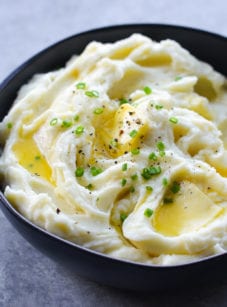
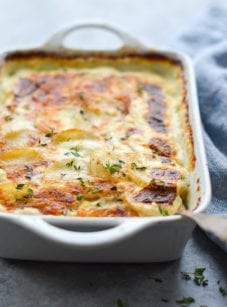
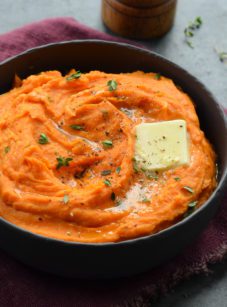
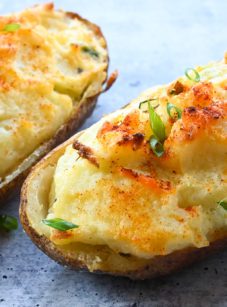
Funny seeing this recipe. Someone asked me just yesterday how to bake potatoes.
I cook them on the oven rack.
If I were cooking them on a tray, I’d use parchment paper. Aluminum can leech into food and we surely don’t want to add aluminum to our bodies.
I’d also use olive or avocado oil as healthier alternatives to vegetable oil.
Thanks for all of your recipes!
Who knew baked potatoes could have so much kid-appeal? They went crazy over the fluffy insides! This is my baked potato recipe going forward.
Jenn- I store my potatoes in the fridge due to our persistent hot weather in the DFW area of TX. Do you think I should pull potatoes out of the fridge to come to room temperature before baking them? If so how long do I give the potatoes to come to room temp? The potatoes are stored in a ~40 degree fridge.
Hi Sandi, I’ve never refrigerated potatoes, but I would think it’s best to let them come to room temperature before baking. This will help ensure they cook evenly. I’d let them sit out for 30 to 60 minutes before placing them in the oven.
Jenn……I just posted a comment and have second thoughts about it. If someone leaves an uneaten hot potato in the foil, “the moisture can create a perfect haven, if bacteria is present, to reproduce when the baked potato cools down while wrapped in foil and hits a temperature of 135 F to 41 F. This temperature range is considered the danger zone. ”
I apologize for not thinking this through before sending in my previous comment! Probably not everyone is aware of this precaution…eat the potatoes while they are hot…unwrap any left-over potatoes!